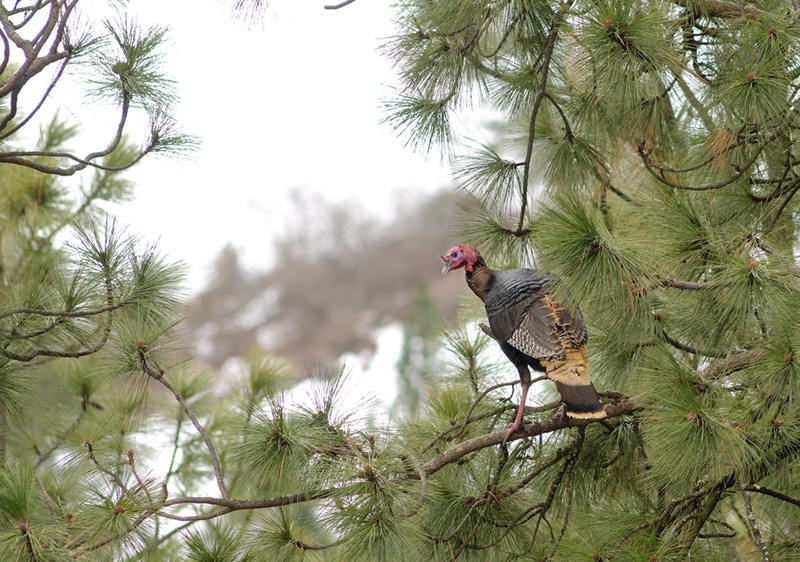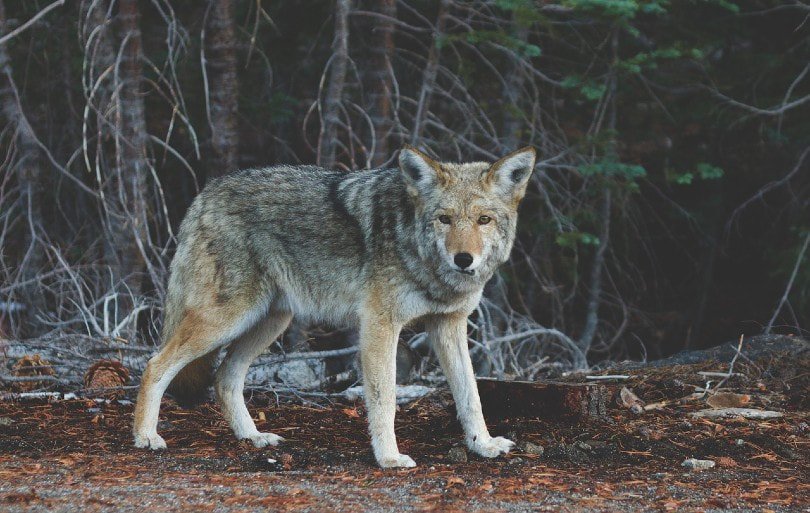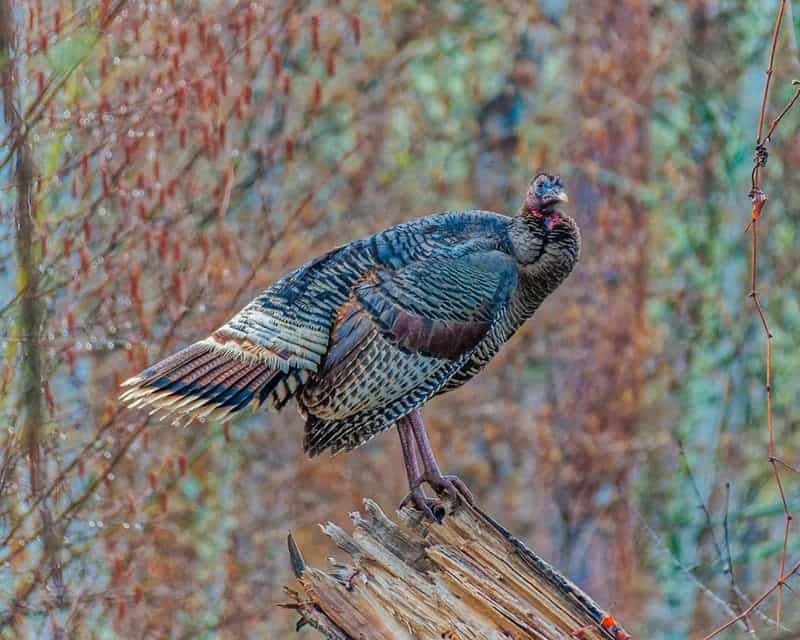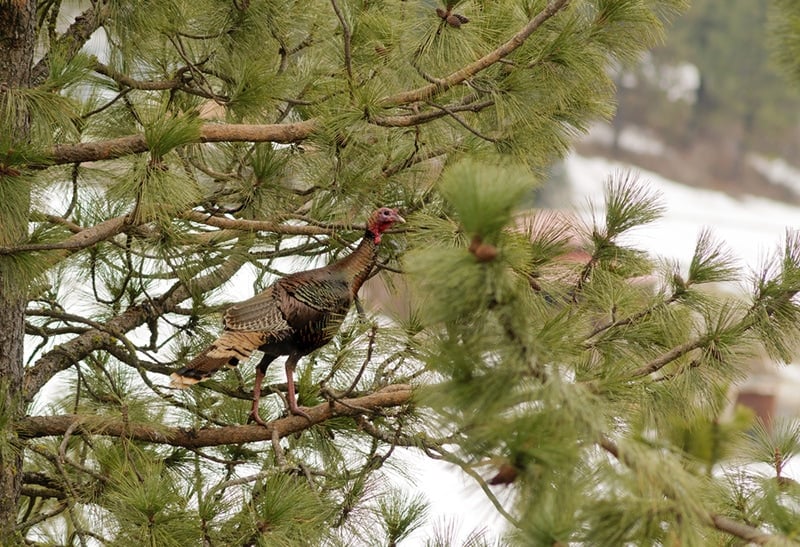Turkeys are diurnal animals with similar habits to us, with the same night blindness too. Turkeys prefer to eat in the late afternoon to early evening hours, retiring to a preferred tree for the night to roost at sunset. Sometimes they roost in social groups, but just as often, one turkey or a pair will roost together on any given night. Turkeys take this valuable downtime to preen their feathers and stretch out before tucking into one wing to sleep.
While it can seem obvious that turkeys hide during the night, there’s quite a bit more to it. In fact, there are several factors that impact how and where turkeys roost. For more details on that, as well as some more specifics on turkey roosting habits, join us as we wade into the world of turkeys below.

Where Do Turkeys Roost? Habits Explained
Turkeys roost in tall trees where predators can’t see or get to them at night when they sleep. Their roosting habits are actually quite complex if you care to get into the details of it. Whether you’re hunting turkey and hoping to glean some insight into their schedule or you’re just curious, we’ve listed some common turkey roosting habits below, including why they roost where they do.
Turkey Roosting Habits:
- Turkeys choose the highest possible tree, preferably ones with cover from the elements like hemlock.
- During the winter, turkeys will roost in the early afternoon to conserve heat and sleep more comfortably.
- The ideal roost is close to both clean water and food sources.
- Turkeys wrap their toes around tree branches with a vice-like grip, preventing strong wind gusts from disturbing their rest.
- The perfect roost has thick, horizontal branches that can easily support the turkey’s weight without bending or breaking.
- Turkeys avoid dense stands of trees and prefer trees with plenty of space around them so they can simply “fall” out of the tree in the morning to forage.

What Factors Impact When and Where Turkeys Roost?
Turkeys choose their roosts for a variety of reasons, from safety, food, their visual abilities, and so on. Identifying why a turkey is attracted to a good roost can help you find them in the future or pinpoint where turkeys might live in the wild.
Factors Which Impact Turkey Roosting:
- Poor Night Vision: Turkeys can’t see very far at night, which makes trees with clear sightlines and nearby open spaces, like clearings, valuable for roosting.
- Local Predators: Turkeys sometimes roost in groups so they can cluster together to sleep, which provides a camouflage effect against keen predator sight.
- Season: Turkeys prefer a nice shady oak during the summer, while trees that offer wind protection, like evergreens, are popular roosts during the snowy winter.
- Ground Cover: Turkeys don’t like surprises and will actively avoid roosting in areas that have lots of ground cover, like bushes and tall grass.
What Are the Turkey’s Natural Predators?
Turkeys are omnivores that eat a variety of smaller animals, but, in turn, they also contribute to the circle of life by becoming prey for other predators. They’re no slouch in a fight, but ultimately, turkeys just aren’t a match for the predators on our list.
Natural Predators of the Turkey:
- Coyote: Coyotes are lithe, swift predators that can easily rush down and overpower an unprepared turkey, especially in coordinated groups.
- Bobcat: Large wildcats and turkeys don’t overlap often, but in some mountainous forests, they can pose an existential threat to turkey populations.
- Hawks and Eagles: These feathered ace hunters can spot and close in on an unwary turkey in mere seconds from hundreds of yards away for a quick meal.
- Raccoons: These crafty striped scavengers prefer to steal turkey eggs, when possible, but are fully capable of taking down a mature turkey in a fight.
- Possums: Possums are another nest predator that makes a large dent into turkey populations with prolific egg theft.
- Foxes: The last of the nest predator trifecta, sly red foxes love purloining turkey eggs and picking off or ambushing wounded turkeys.

What Do Turkeys Eat?
Turkeys are non-picky omnivores that don’t turn their nose up at meat, veggies, plants, or fruits. They’ll dig into the dirt to scavenge for worms, hunt fish, scavenge for nuts, and more in the pursuit of a tasty meal, but what exactly do they eat on a daily basis in the wild?
Turkey Staple Foods in the Wild:
- Insects: Turkeys love a good worm and other invertebrates that live in the dirt, and this preference helps keep them well-fed during the most dangerous winters.
- Fish & Frogs: If available, a turkey will gladly feast on various shallow aquatic creatures like tadpoles, fish, frogs, minnows, and just about anything that moves underwater.
- Nuts & Seeds: Acorns, walnuts, and assorted common seeds are popular turkey staples, supplying lots of protein, fat, and other nutrients in a compact energy-dense package.
- Grasses: Like most birds, turkeys freely graze on fiber-rich grasses nearly anywhere they live in addition to other foods listed here.
- Fruits & Veggies: Turkeys are known to forage for vegetables like squash, cabbage, carrots, lettuce, and much more, and they love roosting near fruit trees for easy access to sweet fruits too.
What Do Turkeys Do All Day?
We’ve established that turkeys are diurnal birds most active during the day, so it’s only natural to wonder what exactly they do during the day. Turkeys are creatures of habit that like to stick to the same areas and routines. Take a look below at some of the stuff you can catch turkeys doing in the wild during this routine.
Turkey Natural Behaviors:
- Gobbling: Mature male turkeys start their day by flying down out of their roost to gobble aggressively at nearly anything nearby, from nesting hens, prey, predators, and so on.
- Mating: Male turkeys typically mate around midday after they’ve spent the morning attracting prospective mates. Males will mate with multiple females if possible.
- Nesting: Female turkeys will spend their afternoon shoring up their nests and laying eggs.
- Loafing: Loafing is a sort of communal turkey relaxation time where they hang out in groups, preen, take dust baths, socialize, or rest.


Conclusion
Turkeys are often seen as bird brains, but they show surprising intelligence for the complex way they choose trees to roost and utilize group camouflage to bamboozle predators. It’s a good thing they’re so good at it because they have quite a few natural predators to worry about!
Featured Image Credit: Jeffrey B. Banke,Shutterstock
